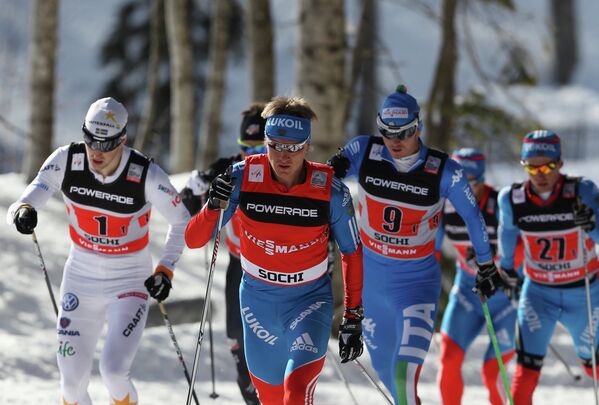The first Olympic Winter Games in Chamonix, France, in 1924, included men's cross-country skiing on 18 km and 50 km courses.

The first Olympic Winter Games in Chamonix, France, in 1924, included men's cross-country skiing on 18 km and 50 km courses.

A women's 10 km cross-country ski competition first featured in the 1952 Games in Oslo, Norway.

Twelve cross-country skiing events feature in the Olympic Winter Games: six men's events and six ladies’ events, including individual races and mass start races, the skiathlon, the relay, and individual and team sprints.

In the individual race, the skiers start at 30-second intervals, and the competitor who covers the distance in the shortest time wins. Participants start in reverse order to their ranking for the season, meaning the athletes ranked highest start last. Racers who are overtaken by faster competitors must step aside if necessary to allow the faster skier to pass. At the Sochi 2014 Olympic Winter Games, men will race in the classical style for 15 km, and ladies for 10 km.

In the mass start race, all skiers start at the same time. 60 to 80 athletes are arranged into rows of 7 to 11 people and start skiing when the pistol shot fires. This format is comparable to bicycle racing, where athletes use various strategies and tactics during the race, and demonstrate their sprinting abilities at the finish line. Men and women race in the free technique events, with men skiing 50 km and ladies skiing 30 km. The use of short loops allows spectators in the stadium to see the contestants every 10-12 minutes. The winner is the skier who finishes first. It is not unusual to have up to 10 athletes vying for the victory in a photo finish.

The skiathlon is one of the most interesting cross-country skiing events. Skiers race the first half of the course on classic technique skis, then exchange them for skating skis in the stadium and finish the event using the free technique. The timer does not stop while the skiers change skis, akin to Formula 1 pit stops. The first skier to cross the finish line wins the skiathlon. Men ski 15 km twice (around a 3.75 km loop) using each technique once (for a total distance of 30km), while ladies cover 7.5 km twice (around a 2.5 km loop) for a total distance of 15km. The competition course is usually laid out in such a way that the skiers pass through the stadium several times.

The individual sprint events begin with a qualifying round, in which skiers start at 15-second intervals and race around a 1.2-1.3 km loop (for women) or a 1.4-1.6 km loop (for men). The top 30 finishers advance to the next round and are placed in quarterfinal heats. Six people start in each the quarterfinal, semifinal, and final races. The two fastest competitors from each heat, plus the two third- or fourth-place skiers with the best times (called the "lucky losers"), advance to the next round. Six skiers compete for the gold medal in the final round.

The team sprint is run as a relay, in teams consisting of two skiers who take turns completing 1.5 km legs three times each, for a total of 6 legs. The event begins with the semifinal round, in which 10 to 15 teams start in each heat, and the top 5 finishers in each semifinal advance to the final. Athletes perform the switchover in a specially designated zone between legs (inside the stadium), without interfering with members of other teams. Teams are placed at the starting line in a way similar to the arrow formation used in the mass start. The team sprint is one of the most exciting events, in which the lead changes often and skiers sustain high speeds. The team that crosses the finish line first after 6 legs wins.

The relay is skied by teams of four athletes. The first and second legs are skied using the classic technique, and the third and fourth using free technique. Ladies ski 5 km legs, while men ski for 10 km. The relay begins with a mass start. The switchover takes place in a specially designated zone in the stadium where team members tag each other. The team that crosses the finish line first after 4 legs wins.

Ski wax comes in two types – either for gliding and for gripping (to prevent the skis from slipping backward when pushing off in the classic technique). The choice depends on the type of snow, weather conditions, humidity, and other factors.

Cross-country skiing events at the 2014 Winter Olympics will be held at the world-class «Laura» Cross-country Ski & Biathlon Center. The seating capacity of the facility is 7,500 spectators.

